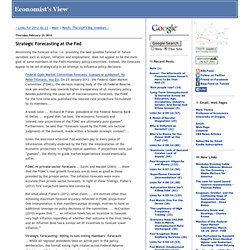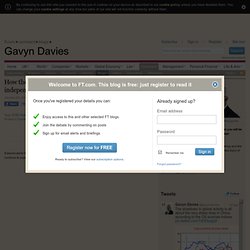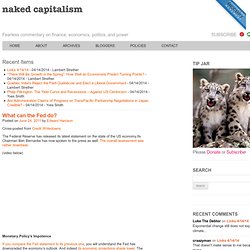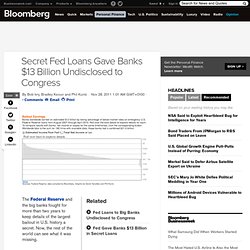

Richard Alford: The Fed’s Orwellian Claims About its Transparency. By Richard Alford, a former New York Fed economist.

Since then, he has worked in the financial industry as a trading floor economist and strategist on both the sell side and the buy side. The US mainstream media (MSM) found a lot to like when the FOMC announced that its current highly accommodative monetary policy stance will continue unless certain “threshold levels” for unemployment and inflation are reached. Chart Of The Day: Fed Interventions Since 2008. The chart below, via Stone McCarthy, shows the months with Fed intervention since December 2008.

That in the past 42 or so months, less than one third have been intervention-free, should close any open questions about whether the stock "market" is anything but a policy vehicle used by the Fed to perpetuate a broke(n) status quo now entirely dependent on every market up (and down) tick. We dread to think what would happen to those record low US bond yields if the market were to be left on its own without the backstop of guaranteed Fed intervention in the interest rate market... ironically something which Barclays is in boiling hot water for right about now.
And a detailed breakdown: Cognitive Regulatory Capture. Roger Lowenstein’s Disgraceful Propagandizing via “Bernanke as Hero” Piece. As Winston Churchill pointed out, history is written by the victors.

The big end of finance, having won decisively in the global financial crisis, is in the process of rewriting history to suit its liking. The cover story in the current Atlantic by Roger Lowenstein on Ben Bernanke, titled simply, “The Hero,” is a classic example of this type of revisionist history. I don’t know what has happened to Lowenstein. His book on the collapse of hedge fund Long Term Capital Management, When Genius Failed, is a terrific piece of reporting. Strategic Forecasting at the Fed. Minimizing the forecast error, i.e. providing the best possible forecast of future variables such as output, inflation and employment, does not appear to be the main goal of some members of the Fed's monetary policy committee.

Instead, the forecasts appear to be set strategically in an attempt to influence policy decisions: Federal Open Market Committee forecasts: Guesses or guidance? , by Peter Tillmann, Vox EU: On 25 January 2012, the Federal Open Market Committee (FOMC), the decision-making body of the US Federal Reserve, took yet another step towards higher transparency of US monetary policy.
Greenspan's Bubbles: The Age of Ignorance at the Federal Reserve. QE III. Insight into macroeconomics and the financial markets from the Financial Times. On macroeconomics Welcome.

If you have yet to register on FT.com you will be asked to do so before you begin to read FT blogs. However, our posts remain free. A blog on macroeconomics, economic policymaking and the financial markets. Gavyn usually writes about a key topic of the week on Sunday. Follow Gavyn Davies on the A-List. Gavyn Davies is a macroeconomist who is now chairman of Fulcrum Asset Management and co-founder of Prisma Capital Partners. He has also served as an economic policy adviser in No 10 Downing Street, an external adviser to the British Treasury, and as a visiting professor at the London School of Economics.
Gavyn Davies is an active investor and may have financial interests and holdings in any of the topics about which he writes. To comment, please register for free with FT.com and read our policy on submitting comments. FEDS Abstract 2011-59. What can the Fed do? Cross-posted from Credit Writedowns.

Secret Fed Loans Gave Banks Undisclosed $13B. The Federal Reserve and the big banks fought for more than two years to keep details of the largest bailout in U.S. history a secret.

Now, the rest of the world can see what it was missing. The Fed didn’t tell anyone which banks were in trouble so deep they required a combined $1.2 trillion on Dec. 5, 2008, their single neediest day. Bankers didn’t mention that they took tens of billions of dollars in emergency loans at the same time they were assuring investors their firms were healthy. And no one calculated until now that banks reaped an estimated $13 billion of income by taking advantage of the Fed’s below-market rates, Bloomberg Markets magazine reports in its January issue. Dear Mr. Bernanke, Don't Mean To Be Rude, But Inflation's Picking Up. The Fed As A Reverse Robin Hood. Fed veteran Thomas Hoenig to retire. Washington Post: What’s behind the steep run-up in prices for oil and other commodities this year, and the decline in the last couple of weeks?

Do you see broader inflation taking root? TH: When you put this much money into the economy, it’s got to deploy. Some of it is deployed into commodity assets. You’re going to have volatility in that environment, and we are seeing volatility. I can’t say that I’m surprised. If you’re talking about a long-term trend line, energy and commodities are trending up, partly because of demand factors, partly because of supply interruptions. Remember, we’re in our third year of zero rates. WP: So is that happening now? The impotence of monetary policy.